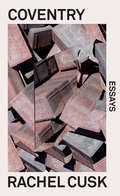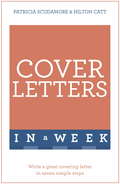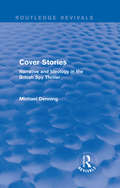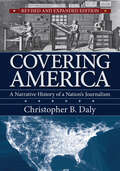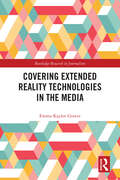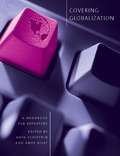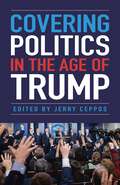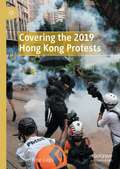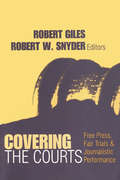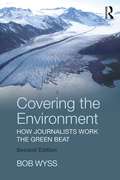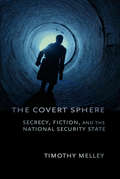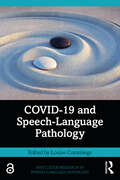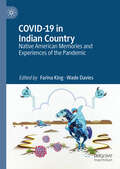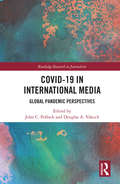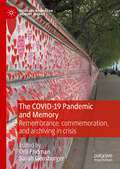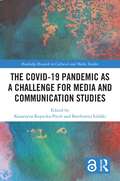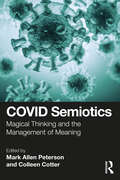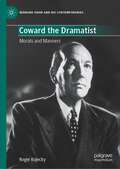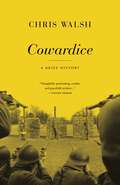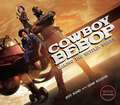- Table View
- List View
Coventry: Essays
by Rachel CuskA selection of her non-fiction writings that offer both new insights on the themes at the heart of her fiction and forge a startling critical voice on some of our most personal, social and artistic questions. Coventry encompasses memoir, cultural criticism and writing about literature, with pieces on family life, gender, politics, D.H. Lawrence, Francoise Sagan and Elena Ferrante. Named for an essay in Granta (“Every so often, for offences actual or hypothetical, my mother and father stop speaking to me. There’s a funny phrase for this phenomenon in England: it’s called being sent to Coventry”), this collection is pure Cusk and essential reading for our age: fearless, unrepentantly erudite and dazzling to behold.
Cover Letters In A Week: Write A Great Covering Letter In Seven Simple Steps
by Hilton Catt Patricia Scudamore<p>Sunday: Understand the importance of first impressions and the common mistakes people make <p>Monday: Ensure your application is taken seriously with a cover letter that is concise, complements your CV and is targeted to the job you have applied for <p>Tuesday: Discover how to style and structure your cover letter with advice on forms of address, etiquette, fonts, margins and the importance of 'white space' <p>Wednesday: Design your cover letter to engage your audience and overcome the competition for advertised jobs <p>Thursday: Design a speculative cover letter to approach the invisible job market <p>Friday: Learn how to address cover letters to agencies and recruitment consultants <p>Saturday: Learn from your applications, whether successful or not, and develop your writing style for the future</p>
Cover Stories: Narrative and Ideology in the British Spy Thriller (Routledge Revivals)
by Michael DenningFirst published in 1987, this title tracks the spy thriller from John Buchanan to Eric Ambler, Ian Fleming and John Le Carré, and shows how these tales of spies, moles, and the secret service tell a history of modern society, translating the political and cultural transformations of the twentieth century into the intrigues of a shadow world of secret agents. Combining cultural history with narrative analysis, Cover Stories explores the two main traditions of the thriller: the thriller of the work, in which bureaucratic routines are invested with political meaning; and the thriller of leisure, in which the sports and games that kill time become a time of dangerous political contests. Examining the characteristic narrative structures of the spy novel – the adventure formulas and the plots of betrayal, disguise and doubles – Denning shows how they attempt to resolve crises and contradictions in ideologies of nation and empire, and of class and gender.
Cover Story (Student Book)
by Daniel SchwabauerCover Story is about more than learning to write well. It's about discovering why writing is (or can be) a lot of fun.
Covering America: A Narrative History of a Nation's Journalism
by Christopher B. DalyToday many believe that American journalism is in crisis, with traditional sources of news under siege from a failing business model, a resurgence of partisanship, and a growing expectation that all information ought to be free. In Covering America, Christopher B. Daly places the current crisis within a much broader historical context, showing how it is only the latest in a series of transitions that have required journalists to devise new ways of plying their trade. Drawing on original research and synthesizing the latest scholarship, Daly traces the evolution of journalism in America from the early 1700s to the "digital revolution" of today. Analyzing the news business as a business, he identifies five major periods of journalism history, each marked by a different response to the recurrent conflicts that arise when a vital cultural institution is housed in a major private industry. Throughout his narrative history Daly captures the ethos of journalism with engaging anecdotes, biographical portraits of key figures, and illuminating accounts of the coverage of major news events as well as the mundane realities of day-to-day reporting.
Covering America: A Narrative History Of A Nation's Journalism
by Christopher B. DalyJournalism is in crisis, with traditional sources of news under siege, a sputtering business model, a resurgence of partisanship, and a persistent expectation that information should be free. In Covering America, Christopher B. Daly places the current crisis within historical context, showing how it is only the latest challenge for journalists to overcome. <p><p> In this revised and expanded edition, Daly updates his narrative with new stories about legacy media like the New York Times and the Washington Post, and the digital natives like the Huffington Post and Buzzfeed. A new final chapter extends the study of the business crisis facing journalism by examining the "platform revolution" in media, showing how Facebook, Twitter, and other social media are disrupting the traditional systems of delivering journalism to the public. In an era when the factual basis of news is contested and when the government calls journalists "the enemy of the American people" or "the opposition party," Covering America brings history to bear on the vital issues of our times.
Covering Extended Reality Technologies in the Media (Routledge Research in Journalism)
by Emma Kaylee GravesThis book presents a study of the news coverage of extended reality technologies (virtual, augmented and mixed reality; or XR) and how this news corresponds with the marketing of XR products. Focusing on a group of recently emerging technological products, the book offers in-depth analysis of the news coverage of XR technologies and explores the overlap between news discourse and promotional discourse by comparing the way these products are framed in the news and their marketing materials. Using both quantitative and qualitative data, it discusses the topics covered in XR news, as well as the sources used and the specific framing techniques that appear in both XR news and marketing materials. In addition to these findings, it also provides a set of frame categories that can be used by other researchers analysing the media coverage of emerging technologies. Ultimately arguing that the news represents XR in such a way that treats readers as consumers instead of citizens, prioritising the interests of XR companies rather than news audiences, this book will be of interest to students and researchers in media and communications, discourse studies, journalism, PR and marketing and innovation studies, as well as XR practitioners.
Covering Globalization: A Handbook for Reporters
by Schiffrin Anya Amer BisatThe first journalism textbook for reporters who cover finance and economics in developing and transitional countries, Covering Globalization is an essential guide to the pressing topics of our times. Written by economists from the Asian Development Bank and the International Monetary Fund as well as journalists who have worked for Dow Jones, the Financial Times, the New York Times, Fortune, and Reuters--and with an introduction by Nobel Laureate Joseph E. Stiglitz--this invaluable resource helps reporters write about subjects such as banking and banking crises, pension reform, privatization, trade agreements, central banks, the World Bank, sovereign debt restructuring, commodity markets, corporate governance, poverty-eradication programs, and the "resource curse." Each chapter explains the basic economic principles and current thinking on a given topic and provides tips on what to look for when covering specific subjects; a way to structure business and economics stories; a way to use the Internet for reporting with links to more information online; extensive glossaries and much more.
Covering Globalization: A Handbook for Reporters
by Schiffrin Anya Amer Bisat Eds.The first journalism textbook for reporters who cover finance and economics in developing and transitional countries, Covering Globalization is an essential guide to the pressing topics of our times. Written by economists from the Asian Development Bank and the International Monetary Fund as well as journalists who have worked for Dow Jones, the Financial Times, the New York Times, Fortune, and Reuters—and with an introduction by Nobel Laureate Joseph E. Stiglitz—this invaluable resource helps reporters write about subjects such as banking and banking crises, pension reform, privatization, trade agreements, central banks, the World Bank, sovereign debt restructuring, commodity markets, corporate governance, poverty-eradication programs, and the "resource curse." Each chapter explains the basic economic principles and current thinking on a given topic and provides tips on what to look for when covering specific subjects; a way to structure business and economics stories; a way to use the Internet for reporting with links to more information online; extensive glossaries and much more.
Covering Politics in the Age of Trump
by Jerry CepposLike politics, journalism has been turned topsy-turvy by the presidency of Donald Trump. Covering Politics in the Age of Trump takes a wide-ranging view of the relationship between the forty-fifth president and the Fourth Estate. In concise, illuminating, and often personal essays, twenty-four top journalists address topics such as growing concerns about political bias and journalistic objectivity; increasing consternation about the media’s use of anonymous sources; the practices journalists employ to gain access to wary administration officials; and reporters’ efforts to improve journalism in an era of twenty-four-hour cable news. Contributors include: Mark Ballard, Peter Bhatia, Rebecca Buck, Carl Cannon, Jill Colvin, Charlie Cook, McKay Coppins, Mary C. Curtis, Paul Farhi, Quint Forgey, Major Garrett, Ginger Gibson, “Fin” Gomez, Jesse J. Holland, Clark Hoyt, Sarah Isgur, Mark Leibovich, Ashley Parker, Fernando Pizarro, Tom Rosenstiel, Frank Sesno, Alexis Simendinger, Steve Thomma, and Salena Zito.The Trump administration’s contentious relationship with the media has altered the public’s expectations regarding the news and national politics. In Covering Politics in the Age of Trump, top political reporters explore this dynamic, relaying stories from the campaign trail to the briefing room that illustrate the new challenges faced by journalists working in the age of “fake news.”
Covering the 2019 Hong Kong Protests
by Luwei Rose LuqiuThis book explores the impact of governmental, institutional, and individual factors on journalists covering protests, using the 2019 Hong Kong Anti-Extradition Bill Movement as a case study. The discussion surveys the challenges frontline journalists have faced while covering protests that unfolded in complex and rapidly evolving geopolitical contexts and media ecologies. Complementing this is an analysis of the Chinese government’s efforts to suppress social movements by curtailing press freedom to silence criticism of the government and keep information about the protest efforts from the public. Separate chapters explore these issues from the perspectives of the citizen journalists, student journalists, and independent journalists who have played key roles in the most recent social movements in Hong Kong. It concludes with a look at the future of press freedom in the city after the passage of the National Security Law.
Covering the Courts: Free Press, Fair Trials, and Journalistic Performance (Media Studies)
by Robert GilesCovering the Courts shows how writers and journalists deal with present-day major trials, such as those involving Timothy McVeigh and O.J. Simpson. The volume features such outstanding contributors as Linda Deutsch and Fred Graham, and provides an in-depth look at the performance of the court in an age of heightened participation by reporters, camera operators, social scientists, major moguls of network radio and television, and advocates of special causes.The volume does far more than discuss specific cases. Indeed, it is a major tool in the study of the new relationships between a free press and a fair trial. Interestingly, a consensus is described in which the parties involved in efforts to balance freedom of the press and the right to a fair trial are moving in tandem. In this regard, sensitive issues ranging from the universality of law to the particularity of racial, religious, and gender claims, are explored with great candor.The volume also turns the intellectual discourse to its major players: the members of the press, the lawyers, and the judiciary. Has there been a shift from reporting functions to entertainment values? Does television and live presentation shift the burden from the contents of a case to the photogenic and star quality of players? What excites and intrigues the public: serious disturbances to the peace and mass mayhem, such as the Oklahoma bombings or sexual adventures of entertainment and sports figures? The findings are sometimes disturbing, but the reading is never dull. This book will be of interest to journalists, lawyers, and the interested general public.This volume is the latest in the Transaction Media Studies Series edited by Everette E. Dennis, dean of the school of communication at Fordham University. The volume itself is edited by Robert Giles, the editor, and Robert W. Snyder, the managing editor, of Media Studies Journal. The original contributions were initially presented at The Freedom Forum and its Media Studies Center.
Covering the Environment: How Journalists Work the Green Beat
by Bob WyssThis practical primer explains the primary issues in writing about the environment, identifies who to go to and where to find sources, and offers examples of writing and reporting the beat. Observations and story excerpts from experienced journalists provide real-world context both for those in the U.S. as well as internationally. Practice story assignments, resources, and a glossary of critical terms gives budding journalists all the tools needed to cover the green beat. Updated with detailed coverage of how companies and climate change have evolved over the past decade, this second edition expands upon the digital sphere and the myriad ways that deadline, multimedia and mobile reporting have changed environmental journalism. Including consideration of issues such as the water crisis in Flint, Michigan, and the GMO controversy, this new edition provides a fresh take on the green beat with a newly organized table of contents and a guide to freelance and entrepreneurial journalism anywhere in the world. Contents include: • an overview and history of the environment and journalism, spotlighting the most significant issues in the beat; • guidance on understanding environmental and health science, ranging from issues of risk, to scientific research and studies, to interviewing scientists; • insights into government and regulatory communities and environmental advocates on all sides of the political spectrum and internationally; • assistance in accessing public records and conducting digital and computer-assisted reporting; • guidance in writing the story for print, broadcast and internet audiences; • an examination of the future of journalism and news coverage of the environment in the U.S. and throughout the world.
The Covert Sphere: secrecy, fiction, and the national security state
by Timothy MelleyIn December 2010 the U.S. Embassy in Kabul acknowledged that it was providing major funding for thirteen episodes of Eagle Four-a new Afghani television melodrama based loosely on the blockbuster U.S. series 24. According to an embassy spokesperson, Eagle Four was part of a strategy aimed at transforming public suspicion of security forces into something like awed respect. Why would a wartime government spend valuable resources on a melodrama of covert operations? The answer, according to Timothy Melley, is not simply that fiction has real political effects but that, since the Cold War, fiction has become integral to the growth of national security as a concept and a transformation of democracy. In The Covert Sphere, Melley links this cultural shift to the birth of the national security state in 1947. As the United States developed a vast infrastructure of clandestine organizations, it shielded policy from the public sphere and gave rise to a new cultural imaginary, "the covert sphere." One of the surprising consequences of state secrecy is that citizens must rely substantially on fiction to "know," or imagine, their nation's foreign policy. The potent combination of institutional secrecy and public fascination with the secret work of the state was instrumental in fostering the culture of suspicion and uncertainty that has plagued American society ever since-and, Melley argues, that would eventually find its fullest expression in postmodernism. The Covert Sphere traces these consequences from the Korean War through the War on Terror, examining how a regime of psychological operations and covert action has made the conflation of reality and fiction a central feature of both U.S. foreign policy and American culture. Melley interweaves Cold War history with political theory and original readings of films, television dramas, and popular entertainments-from The Manchurian Candidate through 24-as well as influential writing by Margaret Atwood, Robert Coover, Don DeLillo, Joan Didion, E. L. Doctorow, Michael Herr, Denis Johnson, Norman Mailer, Tim O'Brien, and many others.
COVID-19 and Speech-Language Pathology (Routledge Research in Speech-Language Pathology)
by Louise CummingsThis collection is the first of its kind to examine the impact of the COVID-19 pandemic on the caseloads and clinical practice of speech-language pathologists. The volume synthesises existing data on the wide-ranging effects of COVID-19 on the communication, swallowing, and language skills of individuals with COVID infection. Featuring perspectives of scholars and practitioners from around the globe, the book examines the ways in which clinicians have had to modify their working practices to prioritise patient and clinician safety, including the significant increase in the use of telepractice during the pandemic. The volume also reflects on changes in training and education which have seen educators in the field redesign their clinical practicum in order to best prepare students for professional practice in an age of COVID-19 and beyond, as the field continues to grapple with the long-term effects of the pandemic. Offering a holistic treatment of the impact of COVID-19 on the work of speech-language pathologists, this book will be of interest to students, researchers, and clinicians working in the discipline. Chapters 5, 6, 10, and 13 of this book are freely available as downloadable Open Access PDFs under a Creative Commons Attribution-Non Commercial-No Derivatives 4.0 license available at http://www.taylorfrancis.com
COVID-19 in Indian Country: Native American Memories and Experiences of the Pandemic
by Farina King Wade DaviesAs the COVID-19 pandemic struck peoples throughout the world, it disproportionately devastated Native American communities. The inequalities, disparities, and injustices they had long experienced as historically marginalized peoples magnified the effects of this crisis throughout Indian Country, causing high hospitalization and death rates, as well as intense economic and social dislocation. This edited volume seeks to tell stories of Native Americans facing this matrix of disease and colonialism in these pandemic years while also highlighting ways that Indigenous people innovated, bonded, and endured through this crisis. It features Indigenous perspectives and experiences through scholarly and creative pieces including short stories, visual art, and academic and personal narratives. Contributors ask how past experiences and traumas have contextualized Native people’s responses to COVID-19 and how intergenerational knowledge and ties have sustained their communities during the pandemic.
COVID-19 in International Media: Global Pandemic Perspectives (Routledge Research in Journalism)
by John C. Pollock; Douglas A. VakochCovid-19 in International Media: Global Pandemic Responses is one of the first books uniting an international team of scholars to investigate how media address critical social, political, and health issues connected to the 2020-21 COVID-19 outbreak. The book evaluates unique civic challenges, responsibilities, and opportunities for media worldwide, exploring pandemic social norms that media promote or discourage, and how media serve as instruments of social control and resistance, or of cooperation and representation. These chapters raise significant questions about the roles mainstream or citizen journalists or netizens play or ought to play, enlightening audiences successfully about scientific information on COVID-19 in a pandemic that magnifies social inequality and unequal access to health care, challenging popular beliefs about health and disease prevention and the role of government while the entire world pays close attention. This book will be of interest to students and faculty of communication studies and journalism, departments of public health, sociology, and social marketing.
The COVID-19 Pandemic and Memory: Remembrance, commemoration, and archiving in crisis (Palgrave Macmillan Memory Studies)
by Orli Fridman Sarah GensburgerThis book offers a platform for the analysis of commemorative and archiving practices as they were shaped, expanded, and developed during the Covid-19 lockdown periods in 2020 and the years that followed. By offering an extensive global view of these changes as well as of the continuities that went with them, the book enters a dialogue with what has emerged as an initial response to the pandemic and the ways in which it has affected memory and commemoration.The book aims to critically and empirically engage with this abundance of memory to understand both memorialization of the pandemic and commemoration during the pandemic: what happened then to commemorative practices and rituals around the world? How has the Covid-19 pandemic been archived and remembered? What will remembering it actually entail, and what will it mean in the future? Where did the Covid memory boom come from? Who was behind it, how did it emerge, and in what social configurations did it evolve?
The Covid-19 Pandemic as a Challenge for Media and Communication Studies (Routledge Research in Cultural and Media Studies)
by Katarzyna Kopecka-PiechThis truly interdisciplinary volume brings together a diverse group of scholars to explore changes in the significance of media and communication in the era of pandemic. The book answers two interrelated questions: how media and communication reality changed during the first wave of the COVID-19 pandemic, and how media and communication were effectively studied during this time. The book presents changes in media and communication in three areas: media production, media content, and media usage contexts. It then describes the theoretical and practical, methodological, technical, organizational, and ethical challenges in conducting research in circumstances of sudden change in research conditions, emergency situations and developing crises. Drawing on various theoretical studies and empirical research, the volume illustrates the principles and results of applying diverse research methods to the changing role of media in a pandemic and offers good practices and guidance to address the problems in implementing research projects in a time of sudden difficulties and challenges. This diverse and interdisciplinary book will be of significance to scholars and researchers in media studies, communication studies, research methods, sociology, anthropology, and cultural studies.
COVID-19 und die Sportkommunikation: Der Einfluss der Corona-Pandemie auf Sport, Medien und Journalismus
by Jörg-Uwe Nieland Thomas HorkyCOVID-19 hat die Sportkommunikation nachhaltig verändert. Der Band bietet empirische Analysen, Einschätzungen und theoretische Ansätze sowie Erfahrungsberichte aus der Praxis zum Einfluss der Corona-Pandemie auf Medien, Journalismus und Sport. Aus unterschiedlichen Perspektiven schauen Wissenschaftlerinnen und Wissenschaftler sowie Personen aus der Praxis auf die Veränderungen in verschiedenen Medien- und Sportorganisationen sowie den Wandel von Produktions- und Arbeitsbedingungen innerhalb der Sportkommunikation. Gleichzeitig lassen sich erste Prognosen für einen Ausblick auf die Zukunft des Mediensports ableiten.
COVID Semiotics: Magical Thinking and the Management of Meaning
by Mark Allen Peterson Colleen CotterThis book examines how people around the world have articulated and shaped their experiences of COVID-19 through a sociolinguistic phenomenon known as magical thinking. Using case studies from throughout the world–China, Egypt, Europe, Jordan, Thailand, East Jerusalem, the UK, and the US–this volume looks at how people managed ambiguity and uncertainty, risk, and social isolation by viewing their experiences of the pandemic as other than, or alongside, those presented by voices and images representing scientifically derived knowledge. Each chapter in the volume introduces the reader to a core semiotic concept and shows how it can be used to analyze and unpack a specific signifying practice. In the conclusion, the several concepts from the chapters–ideological positioning, entextualization and recontextualization, double-voicing, discursive grafting, imaging, and contagion–are revisited and synthesized, in order to demonstrate that semiotics is useful not only in ethnographic studies of various “others” and of various "crises," but also in explaining the quotidian experiences of everyday life. Ultimately, this book reveals that COVID-related magical thinking practices are often as “contagious” as the virus they reimagine, spreading through social media and resulting in such social phenomena as viral videos promoting and rejecting public health practices, the first-lockdown stockpiling of toilet paper and hand sanitizer, resistance to public health recommendations, anti-vax rhetoric, and competing interpretations of emerging public health data. This book not only represents cutting-edge research in the field, but it also provides students of anthropology, linguistics, media, and communication with the vocabulary and conceptual framework to understand the human experience of the COVID-19 pandemic.
A Cow in Town
by Barbara W. MakarA systematic, phonics-based early reading program that includes: the most practice for every skill, decodable readers for every skill, and reinforcement materials--help struggling students succeed in the regular classroom
Coward the Dramatist: Morals and Manners (Bernard Shaw and His Contemporaries)
by Roger KojeckyDiscussions of Coward’s achievement in the theatre between 1920 and 1966 have tended to stay with the colourful biography. The more analytical literary approach adopted here places Coward’s success in its wider theatrical context, making the connections with the work of other dramatists. He developed his technique according to what worked with theatre audiences. Taking up the well-made play, he brought in a more colloquial dialogue, explored, for instance, the morality and psychology of marriage and free love, and frequently exploited the dramatic possibilities of characters grouped into two camps. The book considers both the ‘pleasant’ and ‘unpleasant’ plays (to use the Shavian terms), and the episodic patriotic plays. It Includes Coward’s ambivalent approach to the ‘theatre of war’ in the 20th century. (123)
Cowardice: A Brief History
by Chris WalshA provocative look at how cowardice has been understood from ancient times to the presentCoward. It's a grave insult, likely to provoke anger, shame, even violence. But what exactly is cowardice? When terrorists are called cowards, does it mean the same as when the term is applied to soldiers? And what, if anything, does cowardice have to do with the rest of us? Bringing together sources from court-martial cases to literary and film classics such as Dante's Inferno, The Red Badge of Courage, and The Thin Red Line, Cowardice recounts the great harm that both cowards and the fear of seeming cowardly have done, and traces the idea of cowardice’s power to its evolutionary roots. But Chris Walsh also shows that this power has faded, most dramatically on the battlefield. Misconduct that earlier might have been punished as cowardice has more recently often been treated medically, as an adverse reaction to trauma, and Walsh explores a parallel therapeutic shift that reaches beyond war, into the realms of politics, crime, philosophy, religion, and love.Yet, as Walsh indicates, the therapeutic has not altogether triumphed—contempt for cowardice endures, and he argues that such contempt can be a good thing. Courage attracts much more of our attention, but rigorously understanding cowardice may be more morally useful, for it requires us to think critically about our duties and our fears, and it helps us to act ethically when fear and duty conflict.Richly illustrated and filled with fascinating stories and insights, Cowardice is the first sustained analysis of a neglected but profound and pervasive feature of human experience.
Cowboy Bebop: Making The Netflix Series
by Jeff Bond Gene KozickiOfficial companion book to the Netflix TV series featuring concept art, sketches, behind-the-scenes photography and interviews with cast and crew.Based on the worldwide phenomenon from Sunrise Inc., Cowboy Bebop is the jazz-inspired, genre-bending story of a rag-tag crew of bounty hunters on the run from their pasts as they hunt down the solar system&’s most dangerous criminals. They&’ll even save the world…for the right price. Take a trip behind the scenes of Netflix&’s live-action Cowboy Bebop adaptation! This official companion book is packed full of beautiful concept art and revealing behind-the-scenes photography, as the cast and crew tell the story of how one of the most influential anime series of all time was translated over to live action in this much-anticipated series.
